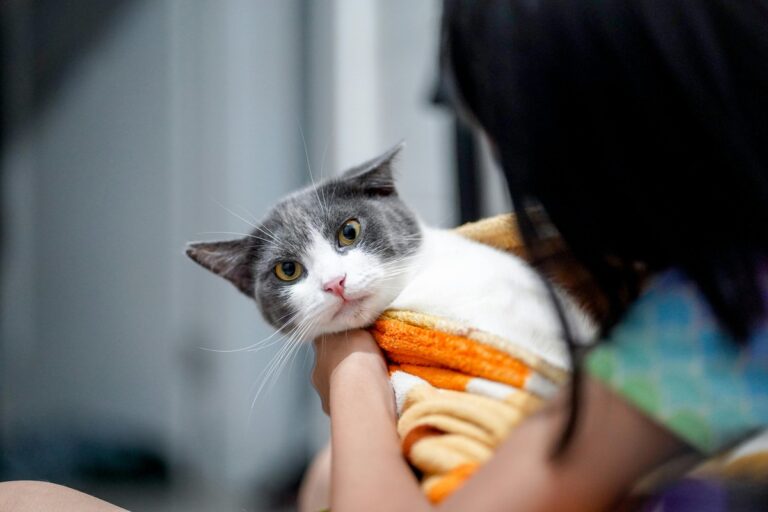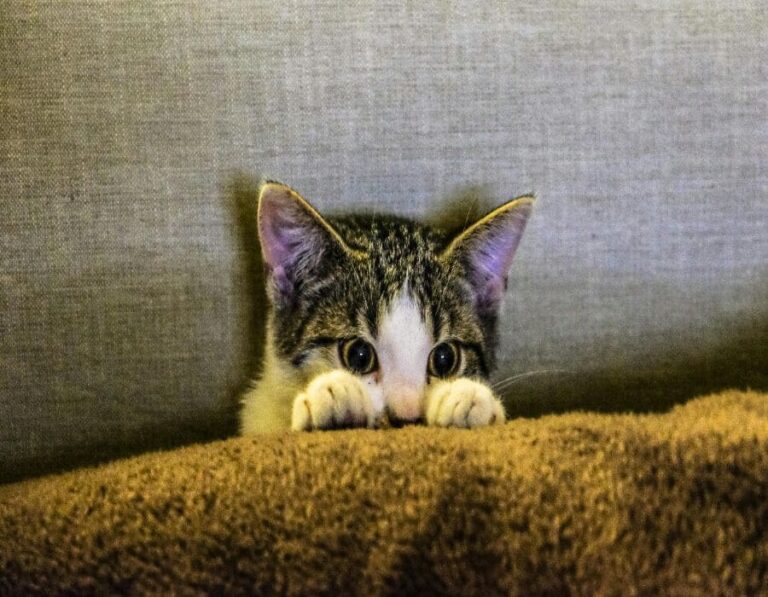20+ Cat Owner Tips: Your Guide to Understanding & Caring for Your Cat
Ever feel like your cat is speaking a secret language? Unlike our tail-wagging doggy pals, cats communicate in meows, purrs, and mysterious stares that can leave us humans feeling clueless. Is that a “feed me meow” or a “scratch my chin now” purr? Confusing!
Becoming a cat person is much more difficult than managing dogs or other pets. One minute your feline friends are purring on your lap, the next they’re staring at the ceiling like you’ve sprouted horns.
Don’t worry, fellow cat enthusiasts, we’ve got your back! Forget boring cat books and overpriced toys (don’t tell your couch I said that!), and get ready to transform your relationship with your cat with the secret cat-approved cat owner tips.
Deep Food Bowls Ruin Your Cat’s Whiskers

The depth of the bowl? Not exactly your top priority, right? Being impressed with a big fish-shaped one or something that resembles a spaceship carries absolutely zero value when your kitty is not happy. Try to use shallow bowl.
So next time when you stroll into the pet store, focus on shallow food bowls. In this way, your cat will not end up rubbing its face at the bowl sides every time. It’s like navigating a culinary obstacle course every time they take a bite.
Many Felines Disfavor Belly Stroking

Most cats are reluctant to belly stroking, indicating their preference for protecting this vulnerable spot. While some cats may allow such gestures as a sign of profound trust, most typically resist belly rubs, especially from unfamiliar individuals.
It’s advisable to refrain from attempting belly rubs on new cats until they establish a sense of trust with you. To clarify, it’s not that cats entirely shun petting in that region; rather, they tend to exhibit a higher level of caution and protectiveness compared to other parts of their bodies.
Prevent Annoying Your Cat with Bell Collars

A small bell on your cat’s collar helps you track them easily. It also prevents your cat from catching birds or mice. However, there are some drawbacks to using these bells as these bells may annoy and irritate your cat.
Cats have really good hearing, and bells can bother them. Imagine if you had to walk around all day with a bell on your neck – you’d probably get annoyed too! So, it’s best not to put a bell on your cat’s collar, especially if your cat gets scared easily.
Mind Your Kitty’s Sensitivity to Chilly Weather

Our cute cats are sensitive to low temperatures, so it’s best not to let them out on chilly winter nights. Cats usually keep their body temperature around 100-102°F. Vets suggest keeping indoor temperatures at least 70°F to keep your cat cozy.
If you notice your cat moving towards heaters, snuggling near the fireplace, or trying to hide under blankets, it’s important to pay attention. These behaviors show that they’re uncomfortable in the chilly weather.
Assist in Soothing with Sweet Delights

If your cat tends to be a bit jittery, there are simple ways you can use to help keep them calm. First, try giving your cat a tasty treat. You can find these treats easily at pet stores and they can be easily attached to surfaces like walls.
If you’re unable to obtain the particular treat your cat enjoys, or if you’re short on time and can’t make a trip to the store, you can opt to lightly spray your cat with water. This action typically triggers an immediate grooming response from your feline friend.
Simplify Your Cat’s Name for Better Recognition

Picking names can be tough, whether it’s for your cat or your child. While giving your cat a long name might seem cute at first, it’s better to choose short names with one or two syllables. Long names can make it harder for your cat to know when you’re calling them.
To help your cat understand and respond better, think about using a shorter name like “Fluffball” or “Nails” instead of “Sharp Fluffball Mcscratchee Nails.” This can make talking with your cat easier and improve how you two interact.
Maintain Optimal Nutrition by Introducing Variety in Their Diet

While numerous pet guardians opt for a single food type, commonly dry kibble, for their cats or dogs, this may not always be conducive to their overall well-being. Instead, diversifying your pet’s diet through periodic changes is often a more advantageous approach.
Dry cat food typically boasts a high carbohydrate content and its inherent lack of moisture can exert strain on a cat’s kidneys. Nonetheless, acknowledging the advantages of dry food, it is prudent to adopt a rotational feeding strategy for a well-rounded diet that caters to their nutritional requirements.
Ensure Your Cat’s Contentment Through Regular Brushing Sessions

While the notion of teaching your cat to wield a brush might seem daunting (given their lack of opposable thumbs), the process is surprisingly straightforward. Cats possess an innate penchant for grooming, and by affixing a cat brush to a wall, you provide them with an irresistible invitation to indulge in self-care.
Moreover, witnessing your cat delicately maneuver a miniature comb across their fur is undeniably endearing, offering an additional layer of delight. However, the primary objective remains to maintain their overall happiness.
Get Your Cat a Scratching Post and Master the Art of Restoration

Cats have gained quite a reputation for wreaking havoc on sofas and cushions with their sharp claws. It’s an innate behavior driven by their natural inclination to scratch various surfaces. Hence, the earlier you acquire a scratching post, the more beneficial it will be.
This material shares the same tactile qualities as the fabric found on a typical scratching post. Consequently, your cat will be inclined to redirect their clawing tendencies towards the post, sparing your furniture from any potential harm, even as the post undergoes wear and tear.
Acknowledge Your Cat’s Efforts for Laser Engagement

While it’s commonplace to reward dogs for obedience, not all cat enthusiasts follow suit. Nevertheless, acknowledging your cat’s participation can solidify positive interactions, particularly during laser pointer play.
Cats possess a natural inclination to pursue moving objects, but futile chasing may lead to dissatisfaction. Therefore, it’s advisable to acknowledge your companion’s efforts after a laser session. This gesture ensures their contentment and reduces potential frustration during playtime.
Maintain Regular Feeding Times to Alleviate Stress

While cats often appear unruffled by the world around them (at least most of the time), even the most composed feline can grow restless if mealtime passes without sustenance in sight. Establishing a routine is beneficial not only for humans but also for animals.
Familiarity breeds comfort for your cat; thus, adhering to a structured routine can minimize the likelihood of anxious episodes, particularly concerning mealtime. The predictability of their daily routine fosters a sense of security, mitigating potential stressors associated with uncertainty, particularly when it concerns their nourishment.
Motivate Your Cat to Utilize Its Litterbox

The majority of felines readily adapt to using a litterbox, often requiring minimal training. Nevertheless, in rare instances, certain cats may perceive the litterbox as inconvenient or uncomfortable, leading them to avoid it altogether. Fortunately, there exists a straightforward method to address this issue.
In the absence of sand, soil, or fabric, another alternative is to introduce paper into the litterbox, although this option may prove slightly less comfortable for your feline companion compared to the former choices.
Prevent Your Cat from Ruining Your Indoor Garden

This is about homes with indoor plants. Sometimes, cats might tear plant leaves or dig up soil from pots and that’s nnot good. To stop this, try adding things like dried flowers or pinecones to your plant setup.
In essence, the goal is to introduce deterrents that dissuade cats from venturing into the pots. You may need to experiment with various methods until you discover the most effective ones for deterring your particular feline friend.
Deal with Aggressive Behavior Between Your Cats

It’s important to give each cat enough room to live together without any problems. If they don’t have enough space, they might fight. One good idea is to put up shelves where each cat can have its own spot to relax and play, away from other cats bothering them.
At first, the cat causing trouble might feel uneasy about setting boundaries and might not want to do it again. But if each cat has their own space, fights can be reduced, making a peaceful place for all cats to live together.
Enhance Trimming Ease by Frequently Handling Their Paws

Getting cats to comply with your needs, particularly when it’s time to extend their claws for trimming, can be a bit tricky. However, there’s a way to acquaint them with paw manipulation. Make an effort to softly grasp or touch their paws regularly.
This will lead them to perceive it as a kind of game, making them much more at ease when the moment arrives to trim their claws. They might even become more inclined to engage in cuddling.
Mix Up Your Cat’s Cuisine

While we touch on this topic elsewhere, the focus tends to be on the distinction between dry and wet cat food. Equally vital is the need to diversify the array of meals your feline friend consumes. Imagine having the same meal repetitively – monotony sets in quickly, and the same goes for your cat.
Therefore, aim to introduce variety into their diet. We’re not suggesting you transform into a gourmet chef for your cat, but simply consider opting for different brands or flavors of cat food occasionally.
Opt for a Flowing Oasis for Your Cat Instead of Stale Water

Here’s a lesser-known nugget of wisdom concerning your cat’s hydration: cats exhibit a preference for running water over the stagnant variety. They are more inclined to drink from a source that moves. However, constructing an elaborate fountain in your backyard isn’t necessary.
You can easily acquire a compact cat fountain from most pet supply shops. Not only will your cat be more inclined to drink from such a fountain, but it will also provide them with a source of amusement.
Don’t Bathe Your Cat So Often

Even if you’re not a seasoned cat parent, it’s common knowledge that felines despise being subjected to a bath. Nonetheless, it appears that the countless scratches and persistent efforts to lure them into the tub may have been unnecessary if you regularly bathe your cat.
Regular baths can also interfere with the natural oil production of their coats, and it’s advisable to limit bathing to instances where your cat is exceptionally dirty or has indulged in some particularly odorous activities.
Preserve Dry Food Freshness with Cereal Containers

It wasn’t something we thought of until recently, but using cereal containers to store dry food is a great idea. Choosing a plastic cereal container instead of a bag is much better for keeping your cat’s food fresh. Dry cat food can get stale quickly, and nobody, not even your cats, likes stale food.
Plus, giving out food is much easier with a container than dealing with a large cat food bag. What’s more, cereal containers can be used again, which makes them a good choice for the environment. So always go for containers.
Focus on Unusual Sounds As They Might Indicate Potential Health Problems

It’s important to note that while your cat’s odd sounds may be just that—unusual noises—sometimes they could indicate health issues. Information from PetMD suggests these sounds might be linked to various health problems, emphasizing the importance of paying attention to your cat’s behavior.
The basic problems could involve high blood pressure and thyroid issues, both of which can become serious health problems if ignored. If your cat makes strange noises, it’s a good idea to ask a vet for advice.
Eliminate Unpleasant Smells in Your Cat’s Litter Box Using Green Tea

Undoubtedly, one of the perks of owning a cat is the assurance that they won’t relieve themselves on your floor or rug. Providing them with a litter box triggers their innate behaviors. Nevertheless, maintaining a litter box involves periodic cleaning, and at times, it can emit unpleasant odors, particularly if left unattended for extended periods.
Just put some dry green tea in your cat’s litter box to eliminate any bad odors that might spread in your home. Your living area will remain clean and nice-smelling. Your cat will also appreciate the fresh scent while using the litter box.
Harness the Power of Baking Soda and Vinegar for Cleaning

When you have a pet, accidents are bound to happen. Vinegar and baking soda are great options for handling these situations. Mix vinegar with water in a spray bottle to fight bacteria well, while a bit of baking soda helps remove both stains and smells.
Interestingly, one need not be a cat aficionado to leverage this insightful cleaning hack. Concerned individuals wary of the potent chemicals present in conventional cleaners can readily adopt this method to sanitize a variety of surfaces.
Never Overfill Your Cat’s Food Dish

If you’ve ever encountered an excessively plump feline, chances are it’s due to overfeeding. Cats tend to consume whatever amount of food is available in their bowl. Consequently, if you top it off completely, they’ll devour the entire portion. Prevent your cat from packing on extra pounds by refraining from filling their dish to the brim during meals.
An overweight cat can face various health complications, and naturally, you desire longevity and well-being for your beloved companion. Keeping your feline friend at a healthy weight is essential for their overall happiness and longevity.
Engaging Your Cats in Play Before Bedtime

This tip isn’t solely for the benefit of your cat; it’s advantageous for you too. Should your cat remain lively even after your bedtime, chances are they’ll be prowling around, disrupting your sleep. Therefore, it’s advisable to organize a play session before both of you retire for the night.
For the best results, keep your cat busy with activities that tire them out. This will help them sleep better, and hopefully, you too. For instance, playing with toys or using interactive feeders can be great ways to keep your cat active and content.
Separate Your Cat’s Food and Water Dishes for a Happy Feline

Normally, people place their cat’s food and water bowls together, but this might not be ideal. Cats prefer to keep their eating and drinking areas separate. Americat suggests that cats don’t like eating next to their water or drinking next to their food.
Moreover, the mingling of food particles with water becomes an unpleasant experience for your cat when the bowls are in close proximity to each other, as is often the case. It’s a situation that compromises the purity of their water and detracts from their mealtime enjoyment.
Keep Up With Air Filters In Your Home

While having a cat in your home can be a joy, they do often come with some baggage, such as odors, allergens, hair, and dust. So, it’s important that you remember to change and check the air filters in your home regularly. This will help prevent you and your cat from developing allergies, and it’ll help your home smell nicer.
Caring for your cat’s health is very important and must not be ignored. Cat litter is also inexpensive and only takes a few minutes, if not less, to change. Your cat and their sensitive nose will thank you for it.
Illuminate the Night for Your Feline Friend

While it may appear that your feline friend possesses extraordinary night vision, the reality is slightly different. Cats indeed have the ability to utilize 50% more ambient light than humans. However, contrary to common belief, they do not possess night vision capabilities.
An additional advantage of this practice is that it reduces the risk of accidentally stepping on your cat while navigating your surroundings in the dark. So more light means happier cat. In turn, fostering a safer and more comfortable environment for both you and your feline companion.
Let Your Cat Familiarize Itself with Carriers

Traditionally, cat and dog carriers carry negative connotations in the minds of your pets, serving as symbols of undesirable destinations. Their entry into these carriers typically coincides with mandatory travels, visits to the veterinarian, or excursions to places they’d rather avoid. It is advisable to regularly leave these carriers accessible and unsealed.
By adopting this approach, you contribute to fostering a sense of comfort in your pets, making their eventual confinement for a journey or a visit to the vet a more tranquil experience. This practice helps alleviate their restlessness and unease during such instances.
Ease Stress in Cats with a Pheromone Dispenser

Although humans can’t sense it, cats release chemicals called pheromones when they’re stressed. For example, if you’ve just brought a new cat home, they’re likely releasing pheromones as they adjust. To help them relax, you can use a pheromone dispenser that plugs into a wall outlet and releases cat-friendly scents.
These dispensers don’t have any smell. You might not notice anything different, but your cat will feel less stressed and more calm. Your house will be a calm place for you and your cat, making it nice for relaxing and feeling happy together.
Understand That Milk Isn’t Good

Many people think that cats love drinking milk, but that’s not entirely true. Most cats can’t digest cow’s milk because they’re lactose intolerant, meaning they have trouble digesting the sugars in it. So, if you want to give kittens a special drink, it’s best to avoid giving them cow’s milk.
If your feline companion has a hankering for milk, you can easily find specialized formulas designed specifically for kittens and adult cats at your local pet store. It’s essential to prioritize their nutritional needs to help them maintain optimal health and vitality.
Ensure Your Pet’s Well-being with Insurance Coverage

Ensuring your pet stays healthy is very important, so it’s smart to get insurance that fits their needs. Dealing with expensive vet bills on your own is not ideal. Choosing pet insurance gives you peace of mind and helps cover unexpected vet expenses.
The cost of veterinary care can rival that of human medical expenses, contingent upon the nature of the ailment. Fortunately, comparing insurance rates from various providers has become increasingly convenient. It also provides peace of mind in the event of unexpected veterinary expenses.
Learn The Art of Feline Aerial Maneuvers

Although cats are generally skilled at landing on their feet, it’s important to keep an eye on your cat’s fancy moves to stop dangerous falls. While cats usually manage to land on their paws safely, there’s still a risk of serious harm if accidents happen.
Cats’ amazing ability to twist and turn in mid-air is all thanks to something called the “righting reflex.” This reflex is closely tied to their natural sense of balance. It’s definitely worth taking a closer look at this impressive skill.
Effortlessly Remove Pet Hair with a Rubber Glove

Try this smart pet hair removal tip. Lots of folks use a vacuum or something like it to get rid of pet hair, but it doesn’t always work great. Instead, try using a rubber glove to gather pet hair. Whether you’re dealing with cat or dog hair, the glove’s natural stickiness helps gather the hair quickly and easily.
Some rubber gloves come with built-in pads, making it easier to remove pet hair. What’s great is that this method is completely free of chemicals and doesn’t need any cleaners. You can also wet the glove with water if you want it to work better.
Keep an Eye on Hairball Occurrences for Health Monitoring

While it’s normal for cats to cough up hairballs, sometimes it might suggest a health problem. An occasional hairball isn’t usually concerning, but if your cat often coughs, gags, or vomits, it’s wise to see the vet. Taking care of your cat’s health is important.
Cats are naturally good at cleaning themselves and dealing with swallowed hair easily. So, if a cat keeps throwing up hairballs, it might mean there’s a health problem that needs looking into. Try to solve this issue immediately.
Shield Your Furniture from Feline Claws with Cardboard

For people who have cats but haven’t gotten a scratching post yet, or for those whose picky cats ignore scratching posts, don’t worry! You can still save your furniture. There are a few ways to protect your couch’s legs. One way is to cover them with cardboard to stop your cat from scratching them. Another option is to use protective tape on the corners.
To stop your cat from scratching your fancy new couch, you can go for either of these options. Just be sure that whatever you choose fully covers the entire couch and doesn’t have any gaps. This way, it works better in keeping your cat from scratching it.






